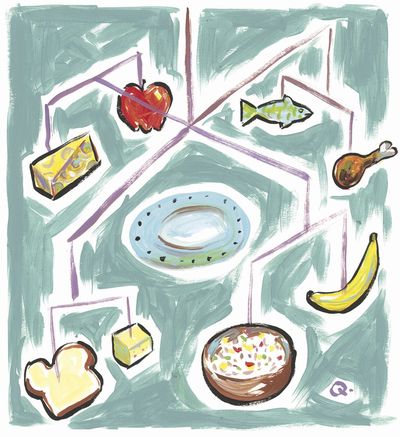Flexitarians on the rise: Palouse group sees increase in diets with additional plants, less meat

Welcome to another trend stretching toward healthy meals: flexitarian, a term increasingly being used to describe people who eat mostly vegetarian meals but still consume some meat.
The diet emphasizes adding more vegetables, fruits, whole grains and plant-based proteins but is broad enough to be, well, flexible.
Its popularity has jumped in the past three years, said Becky Garrison, a registered nutritionist-dietician. She’s director of domestic marketing at USA Dry Pea & Lentil Council and the American Pulse Association – collectively USA Pulses – in the nearby Palouse region.
“When I came into this job three years ago and started working with USA Pulses, even I as a dietician did not exactly know that term,” Garrison said. “Then fast forward three years, and flexitarian is at the heart of what’s happening in trends with foods.”
“In U.S. News & World Report, it’s tied as the No. 2 ranking diet in 2021. This is the first year we saw the flexitarian diet actually tie for No. 2. It’s escalated so fast and really gained momentum. Now, it’s quite commonplace, particularly when we look more at millennials and even the younger Gen Zs.”
That would be Generation Z, born after 1996. Millennials, born from 1981-1996, were ages 24 to 39 in 2020, the Pew Research Center says.
U.S. News & World Report annually lists top-ranking diets related to health that are evidence-based, Garrison said. The No. 1 diet is often the Mediterranean diet, heavy on vegetables, fish and olive oil along with other healthy fare.
The other No. 2 diet this year, tied with flexitarian, is the DASH diet, standing for dietary approaches to stop hypertension. It emphasizes fruits, veggies, whole grains, lean protein and low-fat dairy while discouraging foods high in saturated fat such as fatty meats, full-fat dairy foods and tropical oils.
With growth in flexitarian and similar diets, this year has started out strong for retailing pulses – aka chickpeas, lentils, split peas and beans – as a key food group, Garrison said. The USA Dry Pea & Lentil Council and the American Pulse Association represent the industry’s growers and processors in the U.S.
So this flexitarian rise has the groups’ attention. The term often pops up now in media outlets. Under one survey, it’s estimated that as many as 47% of Americans – including 54% of respondents between ages 24 and 39 – now consider themselves flexitarians. Other studies place the trend closer to about one-third of consumers, Garrison said.
Pulses have long remained popular among vegans and vegetarians, who make up roughly 4% to 6% of the U.S. population, she said. Flexitarians widen this markedly.
“There is this huge chunk of Americans considering themselves to be flexitarians around that concept of trying to add more plants into their diet, so it’s the addition of, or the inclusion of, while gaining the benefits of plant-based foods.”
“If we think about a lot of diet culture, it’s often about pulling things out and removal of certain things. There is some of that concept about reducing consumption of animal-based foods, but the goal is actually to increase plants. That’s where it’s gaining the attention of consumers; there is a lot of flexibility. It’s not strict or this huge commitment that’s very pass or fail.”
The amount of meat consumed by flexitarians doesn’t follow a strict rule, either, she said. It’s more about the general idea of how to consume less meat overall, with room to make convenient meals that different members and ages within a family would enjoy.
As for the why, Garrison said people give different reasons, but they tend to say it’s for personal health or reducing their carbon footprint.
Meatless Mondays has helped people think about meal planning around how to include at least one dinner during the week that’s all plant-based or simply swapping out ingredients to increase plant power.
“Meatless Mondays, I think that’s often where people start,” Garrison said. “Or, they think about how do we swap something out? How do we just do meat as a garnish and have vegetables, fruits and grains be the center of a plate?
“What we see a lot in the pulses world is a lot of folks moving into the phase where they do a portion of a swap. For example, somebody loves burgers, and who doesn’t? They’ll make a beef-based burger but actually do a third of that patty with canned black beans or cooked lentils and mixing that in.
“It’s sort of that flexible world of, ‘I’m not a vegetarian, but I’m working to increase my vegetable intake and, to some extent, decrease my meat intake.’ ”
With that burger example, some people smash up black beans or lentils with a fork, then mix them into the raw ground beef along with seasonings to cook the patties. The pulses add moisture and take on the meat flavor but also boost fiber, vitamins and minerals, Garrison said.
“You’re going to stay fuller longer because of that fiber,” she said. “You’ll reduce the cost by stretching that animal protein source, which can be quite pricey.”
“I think about similar colors. If you look at ground chicken or turkey, and you’re doing meatballs or patties, you can use smashed-up chickpeas and then go about seasoning and cooking. Again, it’s that concept of there is a bit of a swap, and actually that fiber will help to retain moisture and juiciness.”
USA Pulses offers several flexitarian recipe ideas that range from crispy lentil and beef meatballs to black bean and chicken chili on its website pulses.org.
Other information is included in the U.S. News & World Report’s best diets ranking, or find NBC Today’s ”Trying to Eat More Plants? Follow a Flexitarian Diet.”